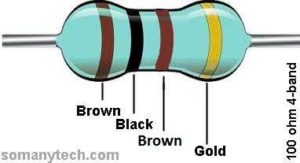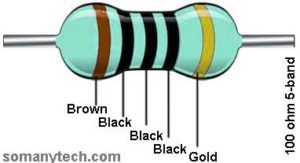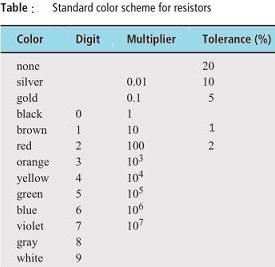100 Ohm Resistor Color Code for 4-band and 5-band resistors
100 ohm resistor color code can be found using the resistor color chart, below image showing a resistor color code of 100R 4-band resistor:

[Brown, Black, Brown, Gold]
The color code for the four bands 100 Ohm resistor is brown, black, brown, gold.
| Band | Color | Value |
|---|---|---|
| Brown | 1 (1st digit) | |
| Black | 0 (2nd digit) | |
| Brown | 10 multiplier | |
| Gold | 5% tolerance |
4-band 100 ohm resistor color code is calculated as:
- 1st-band= Brown= 1 (1st digit)
- 2nd-band= Black= 0 (2nd digit)
- 3rd-band= Brown= 1 (multiplier) = 10^1 = 10
- 4th-band= Gold= ±5% (tolerance)
Thus, 100×1±5% –> 100 ohms –> 100 Ω
The tolerance will be –> 5% of 100 –>5 Ω
Theoretically, the value of 100 Ω resistor is between 95 Ω to 105 Ω
Description: From the chart below we got the color code of resistor with respect to the decimal value of the respective band taken from left to right.
So for 100-ohm resistor, 1st digit is ‘ 1 ‘, ∴ look for color in chart having value 1, then it’s your 1st color(say brown). The next 2nd digit is ‘ 0 ‘, ∴ look for color in chart having value 0, then it’s your 2nd color (say black). Next 3rd digit ‘0’ (but value 10^1 = 10) is multiplier ‘ 1 ‘, ∴ look for color in chart having value 1, then it’s your 3rd color (say brown).
- The last band in 4 and 5-bands resistors is the indicator of tolerance value of the resistor.
In this case, it is Gold which indicates a 5% tolerance value.
For Silver, it is 10%, and 2% tolerance is indicated by Brown. If the 4th band is absent it should be considered as 20% tolerance.
Image showing 100 ohm resistor color code of 5-band resistor:

[Brown, Black, Black, Black, Gold]
The 100R 5-band resistor color code is brown, black, black, black, gold and it is found as:
- 1st-band = Brown= 1 (1st-digit)
- 2nd-band = Black= 0 (2nd-digit)
- 3rd-band = Black = 0 (3rd-digit)
- 4th-band = Black = 0 (multiplier) = 10^0 = 1
- 5th-band = Gold= ±5% (tolerance)
Description:
So for 100-ohm 5 band resistance,
The 1st digit is ‘ 1 ‘, ∴ look for color in chart having value 1, then it’s your 1st color(say brown).
The next 2nd digit is ‘ 0 ‘, ∴ look for color in chart having value 0, then it is 2nd band color (say black).
3rd digit is ‘ 0 ‘, ∴ look for color in chart having value 0, then it is 3rd band color (say black).
Now, 4th digit is multiplier value (10^0 = 1) which is zero, therefore, 4th band will be of black color.
Everything will be the same from the value to the power rating for 5-band resistor and 4 band resistance except the bands painted on them.
Let’s Brush-up resistor color code table and method to find value:
Resistors are widely used and available in a variety of values and power ratings. The lower power resistors typically seen in circuits are marked with color-coded bands painted that give the resistance and the tolerance (i.e., the range of resistance value) as shown in the above figures.
- As pictured in the above 100-ohm resistor, the bands are grouped toward one end of the resistor.
The color band nearest to one of the end is considered as the 1st digit of the value. - The next band is the second digit, the third band is a third digit (in the case of 5 band resistor), the next band is the multiplier, and the last band is for determining tolerance value.The values associated with the various band colors are shown:

For example, a resistor code having colors yellow, violet, orange, and gold corresponds to a value of 47 × 1000 ± 5% Ohms.
Size of resistors:
Resistors also come in variable forms, which means its value can be varied by some means. If the variable resistor has two pins, it is called a rheostat. The more common and versatile type is with three pins called potentiometer or simply a “pot”.
You must select the proper power rating for a resistor whenever required. The power rating of common resistors is indicated by its size. Typical values in watts are 1/8, 1/4, 1/2, 1, 2, 5 watts and so on.
also read what is precision resistor




